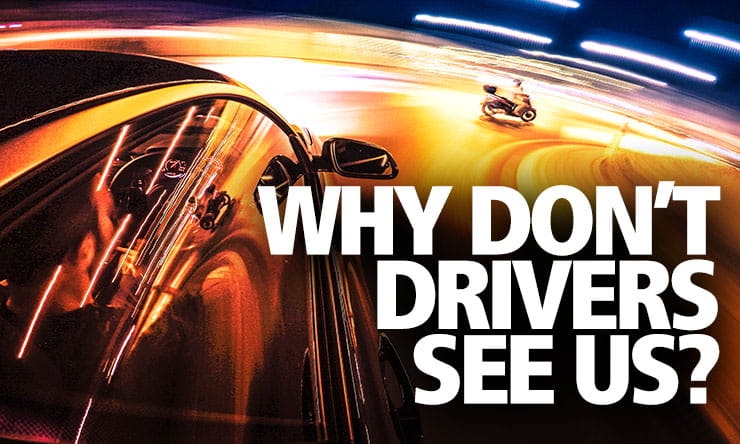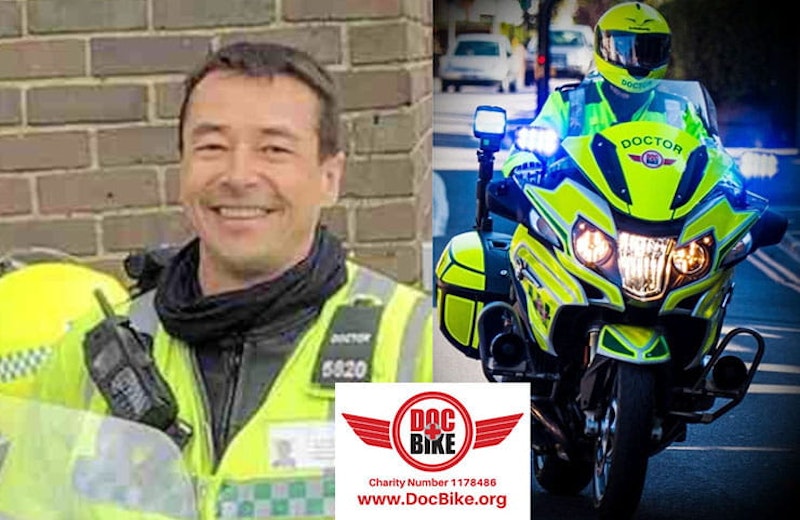Why car drivers don’t see motorcycles and what YOU can do
By Dave Yorke
Freelance journalist
29.01.2021
Dave Yorke, the author of this article, is an ex-Merseyside police motorcycle sergeant and tactical pursuit advisor. He’s owned everything from mopeds at 16 through sportsbikes, off-roaders and super-motos. He currently rides a Honda Africa Twin…
Whenever there’s a serious collision on the roads in the UK – and by serious collision I mean where someone receives a very serious injury and sadly also when those injuries result in a fatality – the police complete a form that bluntly asks questions around a vehicle’s movement.
One of the questions can be answered with a simple ‘going straight ahead’ and another can be answered with ‘at or near a junction’. So, how does a motorcycle travelling straight ahead become involved in a collision at a junction?
The simple answer is that, in a high proportion of cases, another vehicle will be involved.
I spoke to DocBike about its plans to hopefully reduce casualties and how you can help. DocBike, in case you’ve missed it on social media, is a charity passionate about motorbikes, but equally keen to reduce the amount of road deaths amongst motorcyclists. The aim is to get a consultant-level doctor or a critical care paramedic onto two wheels, working wherever possible with a local air ambulance to provide the most seriously injured patients to with the care they need.
But the charity also carries out work on the basis that prevention of a collision is better than dealing with the effects of a collision. Having personally dealt with the devastating effects of fatal motorcycle collisions, I tend to agree with them…
Before DocBike became a charity, the project was set up by Dr Ian Mew (pictured), an air ambulance Intensive Care Consultant, and PC Chris Smith QPM, a police motorcyclist, advanced police motorcycle instructor and Family Liaison Officer with Dorset Police.
How YOU can help shape potentially life-saving road signs
I’m sure we’ve all seen the signs that say “Bends, dead ahead” or “To die for”. In the past there’s been a lot of emphasis on bikes as the sole cause of collisions, but acknowledging and highlighting that there are other causes is definitely a good thing. BikeDoc has a couple of variations on proposed new signs, and they’d like YOUR feedback. Please do use this link to help improve the safety of UK riders: https://docbike.org/evidence-based-road-signs. I’ve filled it in with my thoughts, as has the rest of the Bennetts BikeSocial team; it would be great if you could too...
Which of these signs do you think work best? Please do click the link to have your say: https://docbike.org/evidence-based-road-signs
I asked Dr Ian Mew, one of the DocBike founders about the proposed new signage and why many drivers don’t see motorcyclists at junctions: “The more experienced, more skilful riders among us recognise that while a vehicle pulling out in front of us is not our fault, it’s us the rider that gets hurt,” he said. “To avoid being knocked off our bikes, we can’t rely on other road users seeing us – the brain simply is not built that way.
“‘Think Bike’ signs are great, but if we’re to avoid being knocked off of our motorcycles, we need to be aware that we often are not seen, and be able to stop or avoid that vehicle if it does pull out on us. We may not like it, but these are the facts!
“The DocBike charity will never tell other riders what to do – we believe in the freedom that motorcycling brings and we want to preserve that. But recognising that human brains find it hard to see small profile objects (like motorbikes) travelling towards them at speed, we as bikers have to take the initiative if we’re to stay on two wheels. There’s even a part of our eye that has a blind spot (called the optic disc), where an image (for example a motorbike) falling on this part of the eye will not be seen by the brain.
“The DocBike charity is passionate about understanding why bike collisions occur, and helping fellow bikers to understand the facts, so that they can avoid being in a collision themselves in the future.”
Cover your right eye and look directly at the number three. Can you see the motorcycle in your peripheral vision?
Now slowly move your head towards and away from the screen and you’ll see how the bike vanishes and re-appears.
Riding with the knowledge that other vehicles could pull out in front of us – because we can be hard to see – may well save our lives.
What YOU can do to protect yourself
If drivers can’t always see us, what can we do about it? Well, simply knowing where collisions occur is a vital part of riding, whether you’re out for a weekend ride or on your normal commute. The knowledge that junctions are the places where collisions can happen – and that you might be in a driver’s optical blind spot – should help to ensure that you continue to enjoy your ride. If someone does pull out on you, you’ll be ready to deal with it.
With DocBike engaged in the work they do, and riders and drivers learning where collisions happen, how can the police help? During the year, the NPCC (National Police Chiefs Council) runs campaigns aimed at reducing casualties called Motorcycle Weeks of Action. During those weeks – one in spring and the other traditionally in autumn – it would be great if forces could highlight the work they do around reducing this type of collision, and could tie it in nicely with the dashcam initiative I wrote about recently, helping to educate drivers around the limitations in seeing motorcycles
There’s a clear peak in incidents during Spring
The real world of roads policing
It’s all too easy for some to jump to the conclusion that the rider must have been going too fast when a driver pulls out, but the reasons are far more complex.
Dealing with collisions as a police officer is a strange thing; in every other aspect of policing we deal with both a victim and a criminal who sets out to commit crime.
Roads Policing is different; the overwhelming majority of collisions like these that I dealt with – where vehicles pull out – involved a victim and another member of the public who had often made a very costly mistake. In every other aspect of life they were a nice person (there are always exceptions to the rule), but in the world of roads policing, nice people kill people.
The effects on a driver who makes that mistake can often be absolutely devastating. It’s devastating for everyone involved. These signs should remind drivers to take that extra look for bikes, but also remind riders that collisions have happened there. If it’s successful in Dorset, the scheme could be implemented nationally.
It’s all about sharing the road and looking out for each other, so please take a moment to help the DocBike charity with its research by having your say here: https://docbike.org/evidence-based-road-signs

